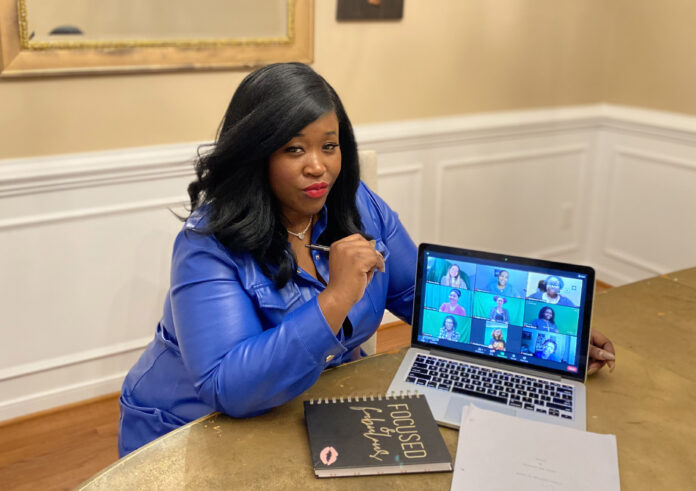
This past weekend, Magic delighted viewers across the country with the world premiere show written and directed by Kiyaana Cox Jones and choreographed by Randall Anthony Smith, assistant professor of dance. The piece ran from Mar. 18-21, allowing for people in the virtual space to enjoy this thoughtful and moving show. The play was a combination of music, dance and spoken text. It reflects on trauma, pain, fear and even genocide. It takes a deep, emotional nose-dive into prevalent issues facing the Black community, and Jones allows for the different elements to highlight the honesty behind the piece’s message.
Magic retells the life of her father and how he died trying to help another woman during a peaceful protest turned into a riot by the actions of non-people-of-color. Jones does a beautiful job of touching on this component of the real world and the dangers of marginalized communities embracing their destinities and their histories.
The real power of this show could be found in Jones’ beautiful direction. In the piece, Bessie, played by Oyinkansola Adebajo ‘24 and Dr. Enchantment, played by Clarissa Shirley ‘22, confront Magic and Bessie reaffirms to Magic that she is already aware of the qualities which make her special. The piece also showcases how others can view this special factor of brown skin girls across the globe.
Jones, a graduate of Howard University, has a wide array of theatrical credits. She created the piece after the passing of her mother, being left with a similar experience to that of the main character, Magic. Jones then looked to her younger sister and daughter to continue their legacy. Additionally, the ways in which the piece was adapted to thrive in a virtual context added to the deep threads of nostalgia woven from Jones’s past.
The play follows a very similar narrative as Magic, played by Krystal Hall ‘21, loses her “magic” after the death of her father. Jones’ direction allows for the piece to feel lively and resonate with audiences despite the virtual distance. The piece takes place in a wide variety of locations, from the streets of New York City to a palace coronation. Dialogue between characters is much more than just a conversation as the performers were able to play and feed off of each other. One scene in particular, featuring Magic and Legacy’s daughter, played by Arianna Tilley ‘22, feels natural and as if it would be a conversation right off a busy New York street. Jones’ smart direction shapes the two characters as if they are angled in at each other and this allows for the virtual screen to blend together to create one unified space.
The virtual backgrounds are another contributor to the piece’s success. The various locations are carefully selected and the virtual backgrounds help to add to the story rather than distract. Magic and Legacy’s daughter both shared the same street view, and the bicycle in Magic’s hands helped to further embrace the scene. In addition, Sistah Genocide, played by Mercy Olajobi ‘21, and other “sistahs” gather in a spacial and non-descriptive space to share their thoughts, prayers and even poetry. Most of the backgrounds are different, but they all showcase the beauty of “Black Girl Magic” and how this can be expressed and liberated in the wide cosmos. Sistah Genocide has a virtual background as she moves and delivers monoprayers to the audience.
For those unfamiliar with the term monoprayers, Jones provides a definition in the program. The artist states, “Monoprayers are pink prayers interlaced with monologues. Pink prayers are the vulnerable, delicate yet crazy faith prayers we share in intimacy with God. Intimacy = into us God sees all of our inadequacies and fears.”
Another major component of the piece was the movement and dance components. AnnaMaria Fernandez ‘24 was the lead dancer and the rest of the talented dancers included Adebajo, Aileen Bergin ‘22, Anya Epstein ‘22, Victoria Gardner, Emma Giordano ‘23, Hall, Olajobi , Imani Smith, Katie Surratt ‘24, Tilley and Bridget Wiggan ‘23. The choreography from Professor Smith allowed for a variety of dance styles and for every dancer to operate at their own comfort level.
The choreography allowed for each artist to be highlighted and for them to dance as one unit, all embracing this magical and supportive community. The songs featured a wide variety of pop styles and women empowerment, featuring the most recent hit by Cardi B. and Megan Thee Stallion “WAP.” The dancing represented a multitude of elements but it primarily focused on women’s liberation and the control of their bodies. The dancing allowed them to embrace their every curve and their beautiful shapes rather than to try to hide who they are. In addition, the piece also featured a lovely music video, “Everything is Everything,” after the coronation of Magic. The video was edited by David Elliot, and multiple members of the cast joined together to sing the catchy tune and to provide emphasis to this important line.
The video montage of Magic as a little girl with her father on the rollercoaster of life was another beautiful touch and cemented how powerful and real this piece is. Overall, Jones combines various methods of storytelling to make a statement about allyship; How women-of-color deserve to be in the room, and how their ancestors and mentors will continue to be together in these spaces.
Johnny '24 is a Theatre and Media and Communication double major at 'Berg. He loves to highlight the voices of artists across campus and to showcase the wide variety of events at Muhlenberg. He likes to think he is funny, but that is up for debate.






















